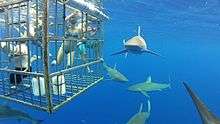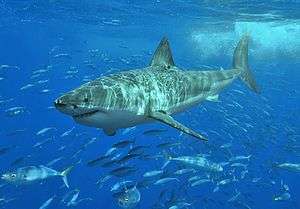Shark tourism

Shark tourism is a form of eco-tourism rooted in having communities appreciate that local shark species are more valuable alive than dead. Instead of opting for a one time economic benefit of harvesting sharks for their body parts, communities are made to assist interested tourists who may want to see live sharks. Many divers and people are involved in interest groups such as the late iDive Sharks Network[1] that aim to celebrate and promote safe and responsible shark diving activities.[2] Another diver and marine biologist who focuses on shark conservation and promotes this form of ecotourism is Ocean Ramsey, who operates a company called One Ocean Diving out of Hawaii. Her program, just like many others, focuses on educating the public about these animals and allowing guests to get a first hand experience with them. This personal connection helps the general public realize their significance and in return want to help them.[3]
Categories
Shark tourism is divided into 4 main branches. Viz:
- Great White sharks - surface viewing in cages mainly.[4]
- Tigers, Bulls Oceanic White Tips, and other less harmful [but potentially dangerous]sharks - in open - offshore water and referred to as Pelagic diving.
- Ragged Tooth / Sand Tiger / Grey Nurse sharks who tend to congregate on certain reefs and wrecks at specific times of the year.
- Basking and Whale sharks - Harmless plankton feeders.
Great white shark

Great White Shark viewing is available at the Neptune Islands[5] in South Australia, South Africa, Isla Guadalupe in Mexico, and New Zealand - where Great White sharks are viewed using shark cages to keep the diver safe. Except for Isla Guadalupe where because of the exceptional visibility underwater more outside the cage diving is done than anywhere else.[6]
The Great White industry was founded in the 1970s by pioneer Australian diver and Great White attack survivor Rodney Fox in South Australia. He was the sole world-wide operator until the South African industry was founded in early 1989 by Pieter van der Walt. He was joined shortly thereafter by pioneer diver and underwater photographer George Askew who handled promotions and put South African cage diving "on the map" with the publicity he got - until they split in Jan 1992, after they, together with famous Australian divers, Ron and Valerie Taylor, did the world's first dive amongst Great White sharks without a cage and completely unprotected.[7]
This 'Frontier Pushing' dive was directly responsible for the upsurge in Shark Tourism – esp free-diving (i.e. Out of cage) swimming with big sharks. When would be operators around the world became aware of these four mad people who proved that the Great White was quite approachable and not likely to attack – thought that then maybe all the other 'Bad Boy' sharks like Tigers, Bulls and Oceanic's were safe to swim with too. This proved to be the case and shark tourism has become a multi-million-dollar a year industry.[8]
Tiger, bull and oceanic white tip
The Bahamas is a favorite region for Category 2 sharks. Whilst divers in the Bahamas experience Reef Sharks and Tiger Sharks while they are hand-fed. Isla Guadalupe located in Mexico has been named a Bio-Sphere Reserve in an effort to control the shark diving activities there. Although the practice of shark diving proves to be controversial, it has been proven very effective in attracting tourists. Whale Sharks, while not traditionally harvested for their fins but are sometimes harvested for their meat, have also benefited from Shark Tourism because of snorkelers getting into the water with the gentle giants. In the Philippines snorkelers must maintain a distance of four feet from the sharks and there is a fine and possible jail time for anyone who touches the animals.[9]
All manner of Reef Shark species are prevalent at the many shark feeding dives within the Pacific Region. Grey Reef sharks are the main diners in places such as the Great Barrier Reef, Micronesia and Tahiti. Silvertips and Black Tips Reef Sharks tend to be more seen around the PNG coastlines. Bull Sharks are around Mexico, Playa del Carmen in particular.[10]
Conservation benefits
Passive and active forms of shark tourism are believed to conserve the species by generating commercial value to their lives in the natural world. In North Carolina wreck divers regularly visit the World War II shipwrecks to dive with the Sand Tiger sharks that make the wrecks their home.[11]
Feeding
Tourism providers often provide food to attract sharks to areas where they can be more easily viewed, although this is controversial.[12] In Australia's Great Barrier Reef Marine Park and the states of Hawaii and Florida shark feeding is prohibited.[13] Hawaii had several issues with the banning of shark feeding. The initial law that prohibited it was passed in 2002, but many locals realized the tour companies were not following this law and pushed for stricter enforcement.[14]
Shark Tourism in Hawaii

Sharks, or 'mano' as they are called by the local Hawaiians, are viewed as sacred. Early Hawaiians worshiped and protected the sharks which they saw as family gods or 'aumaka'.[15] In recent years, shark cage diving has become a very profitable tourist attraction in the state. Native Hawaiians were not pleased with this at first due to the fact that the companies were luring in the sharks using bait; they viewed these animals as sacred and feeding them for entertainment was said to be unjust.[16] There was also speculations that by feeding them, the sharks would begin to associate the boats and humans with food. For this reason, a bill was passed in Hawaii in 2002 that banned the feeding of sharks in state waters, which is about 3 miles off shore.[17]
References
- ↑ "The Inglorious End of iDive Sharks?". http://sharkdivers.blogspot.com. Retrieved 26 August 2015. External link in
|website=(help) - ↑ Zenato, Christina. "Shark Diving, Shark Feeding, and Common Sense". sharksavers.org. Retrieved 26 August 2015.
- ↑ TEDx Talks (2015-09-28), How sharks affect us all | Ocean Ramsey | TEDxKlagenfurt, retrieved 2016-05-04
- ↑ Shark Tourism (December 2013), White Shark Ecoventures, Shark Tourism, p. 1
- ↑ "Shark cage diving". Department of Environment, Water and Natural Resources. Retrieved 12 December 2013.
- ↑ Ward, Terry. "Diving with the Great White Sharks of Guadalupe Island". AOL Travel. Retrieved 20 August 2015.
- ↑ David Seifert, Douglas. "A tribute to Ron Taylor". sharksavers.org. Retrieved 20 August 2015.
- ↑ "Ecotourism: Dollars and Sense". sharksavers.org. Retrieved 16 August 2015.
- ↑ Cannon, Marisa. "Swimming with whale sharks in the Philippines". cnn.com. CNN. Retrieved 16 August 2015.
- ↑ Van Der Haar, Nils. "Why not to Bull Shark Dive in Play Del Carmen". http://scubadiverlife.com. Retrieved 20 August 2015. External link in
|website=(help) - ↑ Decker, Robert. "Ghosts in the Graveyard: N.C. Shark Diving". ScubaDiving.com. Retrieved 17 June 2015.
- ↑ Higham, James; Lück, Michael (2008). Marine Wildlife and Tourism Management: Insights from the Natural and Social Sciences. CAB International. p. 58. ISBN 978-1-84593-345-6.
- ↑ Great Barrier Reef Marine Park Authority. "Environmental Status: Sharks and rays: Response: tourism". Retrieved 2013-07-10.
- ↑ "Hawaii's shark tours persist despite laws against feeding - Mauinews.com | News, Sports, Jobs, Visitors Information - The Maui News". mauinews.com. Retrieved 2016-05-06.
- ↑ "The Honolulu Advertiser - Island Life". the.honoluluadvertiser.com. Retrieved 2016-05-03.
- ↑ Taylor, Leighton R. (1993-01-01). Sharks of Hawaii: Their Biology and Cultural Significance. University of Hawaii Press. ISBN 9780824815622.
- ↑ "Global Law and Regulation". policy.mofcom.gov.cn. Retrieved 2016-05-03.
External links
- Scuba divers swim among the sharks, Fayetteville Observer
- Sand Tigers Video